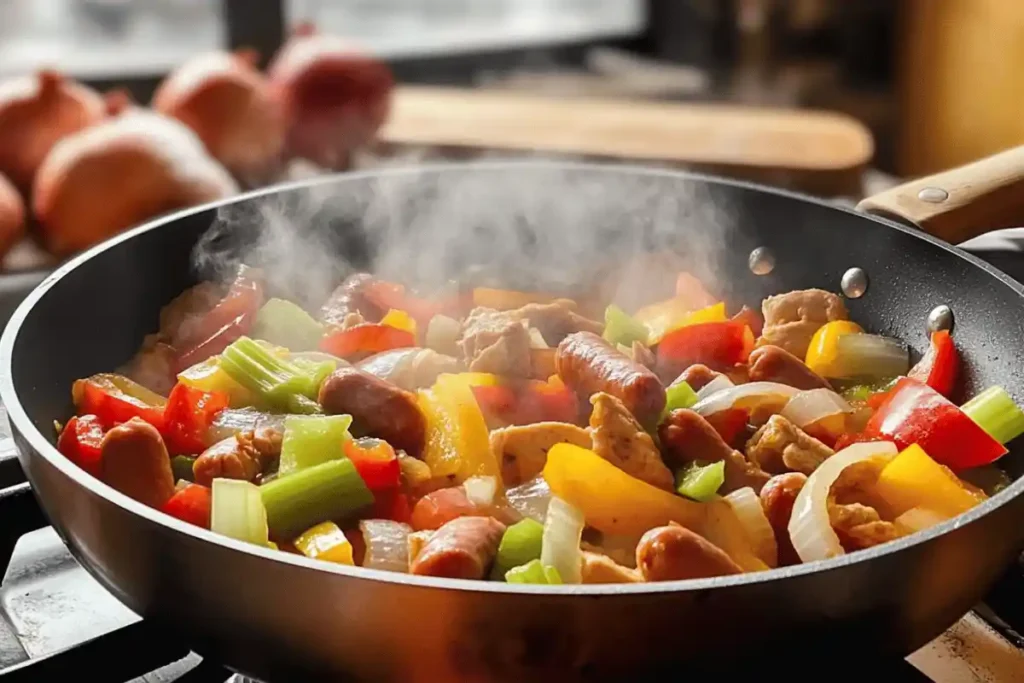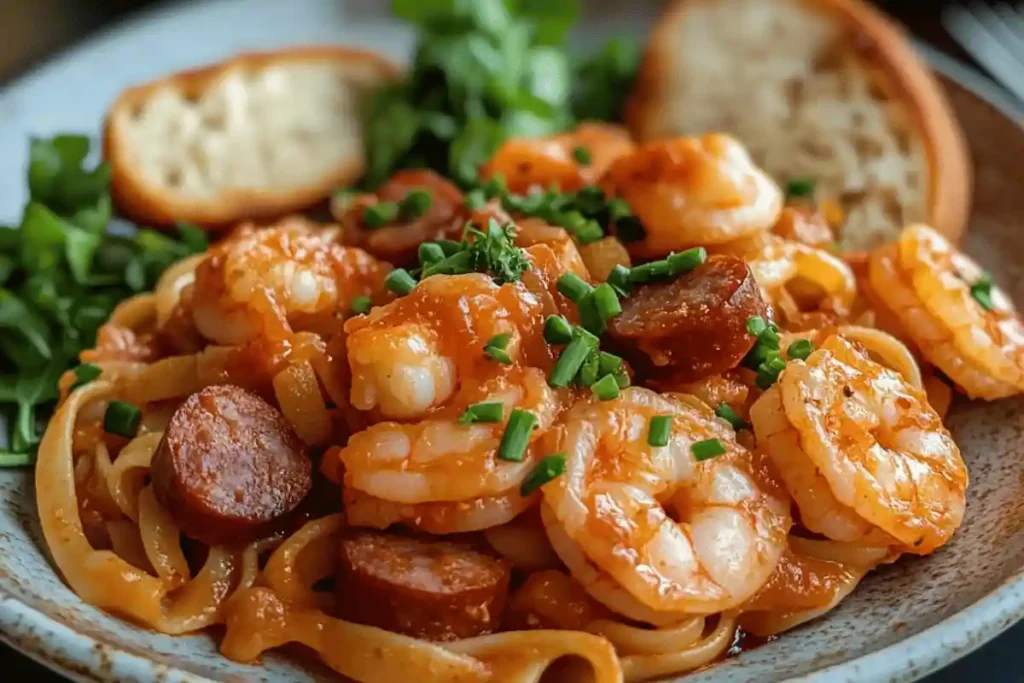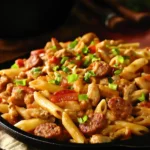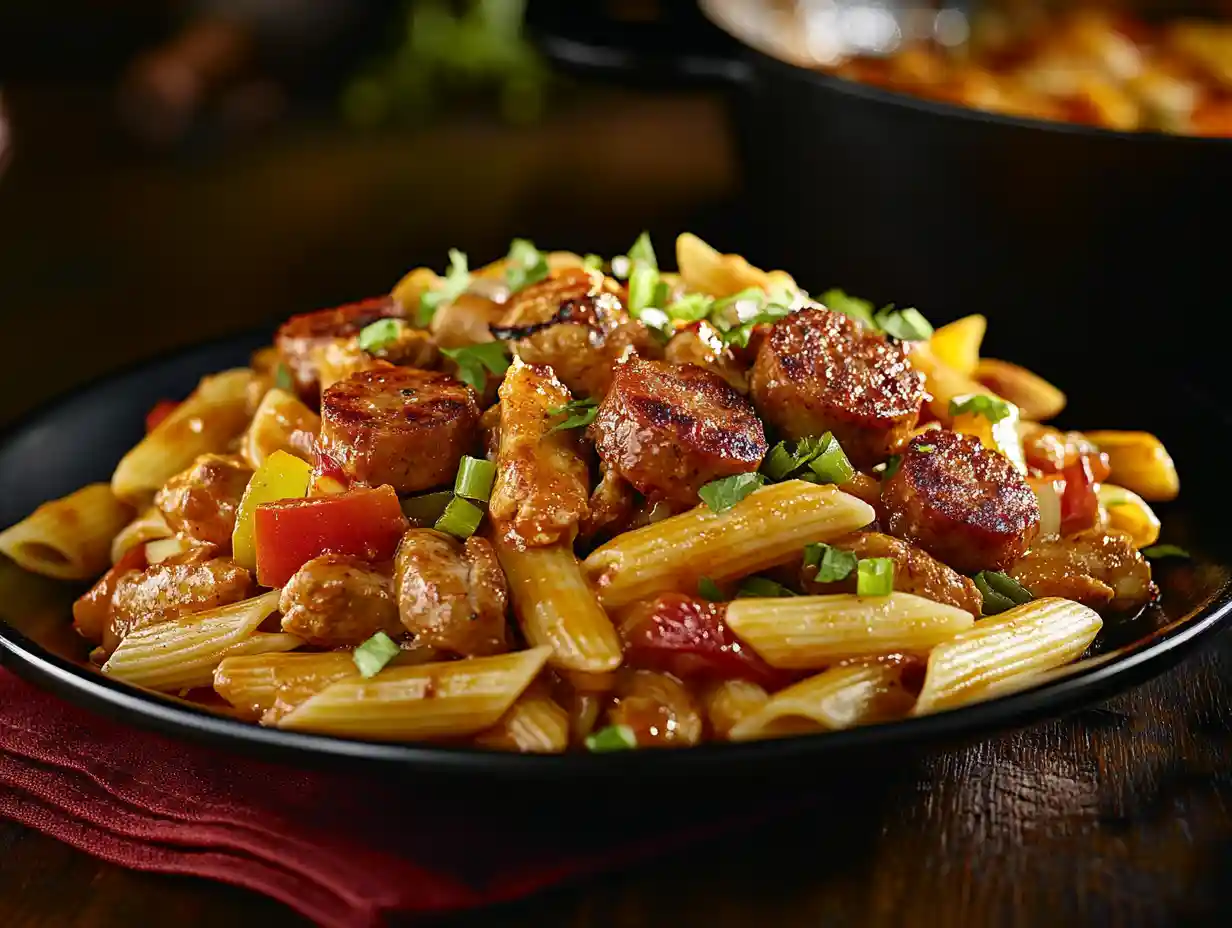Table of Contents
Introduction to Pastalaya Recipe
The Pastalaya Recipe is a versatile dish that offers something for everyone, whether you stick to the classic version or try one of its many variations. Its rich, smoky flavors, easy preparation, and adaptability make it a meal you’ll return to time and again. So grab your ingredients, fire up your stove, and get ready to create a Pastalaya Recipe that’s sure to impress.
What is Pastalaya?
The Cajun Pasta Dish You’ll Love
Pastalaya is a savory Louisiana dish that combines the essence of jambalaya with the simplicity of pasta. Instead of rice, this recipe swaps in pasta, creating a heartier version of the classic Creole favorite.
Origins and Traditions of Pastalaya Recipe
Pastalaya originated in Cajun country, where the love of good food and practicality go hand in hand. Italian immigrants in Louisiana adapted jambalaya recipes, using pasta as a base while keeping the smoky, spicy, and robust flavors intact. Over time, it became a staple at potlucks, festivals, and family gatherings.
How Pastalaya Differs from Jambalaya
While traditional jambalaya features rice, Pastalaya uses pasta, typically rotini, penne, or even spaghetti. Both dishes share similar seasonings and ingredients, such as the “Holy Trinity” of Cajun cuisine—onions, bell peppers, and celery—but the pasta gives it a unique twist.
Why It’s a Crowd Favorite
Pastalaya is not just delicious but also incredibly versatile. Whether you prefer it spicy or mild, loaded with meat or vegetarian-friendly, this dish adapts to your taste buds with ease. Plus, it’s a quick and fuss-free option when you’re short on time yet crave something homemade and satisfying.
History and Origin of Pastalaya
The Roots of Pastalaya
Pastalaya Recipe is deeply rooted in the rich culinary traditions of Louisiana, where bold flavors and hearty meals have always been a way of life. Interestingly, this dish is the result of a beautiful fusion of cultures—primarily the Cajun influence and the Italian immigrant communities that settled in the region. Over time, as pasta became a common pantry staple, Cajun cooks began swapping rice for pasta in their beloved jambalaya recipes. Consequently, this innovative adaptation created a delicious hybrid that is now cherished by many.
The Italian Influence on Cajun Cooking
Italian immigrants played a significant role in shaping Louisiana cuisine. They brought their love for pasta, which, when combined with Cajun spices, sausages, and the Holy Trinity (onions, bell peppers, and celery), gave rise to dishes like Pastalaya. Over time, this fusion evolved into a beloved dish shared at family dinners, festivals, and celebrations across the state.
How Pastalaya Spread Beyond Louisiana
Once a local specialty, Pastalaya has grown in popularity far beyond Louisiana. Its adaptability and rich flavors make it a favorite in other parts of the U.S., particularly among fans of Southern comfort food. This dish exemplifies the creativity of Cajun cuisine, blending practicality with deep, satisfying tastes.
Pastalaya as a Symbol of Cajun Culture
In many ways, Pastalaya is more than just food—it’s a cultural icon. It reflects the resourcefulness of Cajun cooks who used available ingredients to craft something extraordinary. Whether enjoyed at a bustling Mardi Gras party or a quiet weeknight dinner, Pastalaya carries the spirit of Louisiana’s food traditions.
Ingredients Used in Pastalaya Recipe
Key Proteins for the Dish
- Andouille Sausage: Smoky and spicy, it’s a signature ingredient in many Cajun dishes, lending depth to Pastalaya.
- Chicken: Tender, juicy chicken complements the sausage perfectly. Use thighs for richer flavor or chicken breasts for a leaner option.
- Shrimp (Optional): For a seafood twist, shrimp adds a delightful sweetness and works well with the Cajun spices.
- Vegetarian Alternatives: If you prefer a meat-free version, smoked tofu or plant-based sausages are excellent substitutes.
Essential Vegetables
- The Holy Trinity: Onions, bell peppers, and celery form the backbone of Cajun cooking. They bring a balance of sweetness, crunch, and aroma.
- Additional Options: Consider adding diced tomatoes, garlic, or even okra for extra layers of flavor.
Seasonings and Spices
- Creole Seasoning: A blend of paprika, garlic powder, onion powder, cayenne pepper, and herbs, it defines the bold flavor of Pastalaya.
- Cayenne Pepper: For those who love heat, cayenne brings just the right kick.
- Black Pepper and Salt: Simple but essential for seasoning.
Choosing the Right Pasta for Pastalaya Recipe
- Pasta Types: Penne, rotini, or fettuccine work best as they hold the sauce well. Avoid delicate pasta like angel hair, which may become mushy.
- Texture Matters: Cook the pasta al dente to maintain a slightly firm bite. This prevents it from turning overly soft when combined with the other ingredients.
Additional Ingredients
Stock or Broth: Whether you choose chicken or vegetable stock, it is absolutely vital for cooking the pasta while simultaneously infusing it with rich, savory flavor. This step ensures that the pasta absorbs the seasonings and enhances the overall taste of the dish.
Oil or Butter: For sautéing vegetables and proteins, both oil and butter work wonderfully. Not only do they add richness, but they also create a smooth base for blending the other ingredients, ensuring every bite is flavorful and satisfying.
Why These Ingredients Work Together
The true beauty of Pastalaya Recipe lies in the harmony of its ingredients. For instance, the smoky sausage provides depth, the tender chicken offers a hearty texture, and the aromatic vegetables bring a subtle sweetness that balances the dish. Furthermore, all these elements blend seamlessly with the pasta, creating a symphony of flavors. When tied together by the bold spices and, optionally, a creamy sauce, every bite becomes a celebration of Louisiana’s culinary ingenuity.
Step-by-Step Guide to Making Pastalaya Recipe

Ingredients List
Proteins:
- 1 pound of andouille sausage, sliced
- 1 pound of chicken thighs or breasts, diced
- Optional: ½ pound of shrimp, peeled and deveined
Vegetables:
- 1 large onion, diced
- 1 green bell pepper, diced
- 2 celery stalks, chopped
- 3 cloves garlic, minced
Seasonings and Spices:
- 2 tablespoons Creole seasoning
- 1 teaspoon cayenne pepper (adjust to taste)
- 1 teaspoon black pepper
- Salt, to taste
Pasta and Liquids:
- 1 pound of penne or rotini pasta
- 4 cups chicken stock (or vegetable stock for a vegetarian version)
Additional Ingredients:
- 2 tablespoons olive oil or butter
- Optional: ½ cup diced tomatoes (for a tangy kick)
- Optional: Fresh parsley and green onions, chopped, for garnish
Cooking Instructions
Prep Your Ingredients
- Slice the sausage, dice the chicken, and chop all vegetables beforehand. This makes the cooking process smoother.
Cook the Proteins
- Heat olive oil or butter in a large skillet or pot over medium-high heat.
- Add the sausage slices and cook until browned (about 3-4 minutes). Remove and set aside.
- In the same pot, add the chicken pieces, seasoning them lightly with salt and black pepper. Sear until golden on the outside but not fully cooked (about 5 minutes). Remove and set aside.
- If using shrimp, cook it last for 1-2 minutes per side, just until pink. Set aside.
Sauté the Vegetables
- Add a little more oil if needed, then toss in the onions, bell peppers, and celery. Sauté for 5-7 minutes until softened and aromatic.
- Add the minced garlic and cook for another 1-2 minutes, being careful not to burn it.
Build the Base
- Return the sausage and chicken to the pot. Mix them with the vegetables.
- Sprinkle in the Creole seasoning, cayenne, and black pepper. Stir well to coat everything evenly.
Add Pasta and Stock
- Pour in the chicken stock, ensuring the ingredients are fully submerged.
- Add the pasta, stirring to combine. Bring the mixture to a boil, then reduce to a simmer.
- Cover the pot and cook for about 15 minutes, stirring occasionally, until the pasta is al dente and has absorbed most of the liquid.
Final Touches
- If using shrimp, add it back to the pot during the last 2-3 minutes of cooking.
- Adjust seasonings as needed—add more salt, black pepper, or cayenne if you prefer extra heat.
- Garnish with chopped parsley and green onions before serving.
Nutritional Information (Per 100g)
| Nutrient | Amount |
|---|---|
| Calories | 240 kcal |
| Protein | 12 g |
| Total Fat | 9 g |
| Saturated Fat | 3 g |
| Carbohydrates | 26 g |
| Dietary Fiber | 2 g |
| Sugar | 3 g |
| Sodium | 480 mg |
This recipe makes approximately 6-8 servings.
Variations of Pastalaya Recipe
Seafood Pastalaya
For a coastal twist, seafood Pastalaya replaces chicken and sausage with shrimp, crawfish, or even crabmeat. It’s a crowd-pleaser for seafood lovers and brings a fresh, briny taste to the dish.
- Key Adjustments: Use seafood stock instead of chicken stock for added depth. Shrimp and other seafood cook quickly, so add them in the final minutes to avoid overcooking.
Vegetarian Pastalaya
Who says Pastalaya Recipe can’t be meatless? In fact, this version swaps the proteins for hearty vegetables and plant-based sausages, making it an excellent option for vegetarians. Additionally, it’s every bit as flavorful and perfect for those wanting a lighter yet satisfying meal.
Key Ingredients: For the best results, smoked tofu, mushrooms, zucchini, or eggplant can easily replace the traditional meats. Moreover, using vegetable stock instead of chicken stock ensures a rich, vegetarian-friendly base. Don’t forget to load up on spices to keep the bold flavors that make Pastalaya Recipe special.
Creamy Pastalaya
If you love creamy pasta dishes, this variation is definitely for you. Not only does it retain the signature Cajun spices, but it also introduces a luscious, creamy texture for a richer and more indulgent take on Pastalaya Recipe.
Key Additions: To achieve the perfect creamy consistency, stir in ½ cup of heavy cream or cream cheese toward the end of cooking. Additionally, some recipes suggest adding a handful of shredded cheddar or Parmesan for an extra layer of decadence.
Spicy Pastalaya
For those who crave heat, this spicier version is the way to go. It allows you to amp up the flavor by doubling the cayenne pepper, adding diced jalapeños, or using hot smoked sausages. Not only does this enhance the spice level, but it also makes the dish even more exciting for those who love bold flavors.
Gluten-Free Pastalaya
For anyone with dietary restrictions, don’t worry—Pastalaya Recipe can still be enjoyed! Simply opt for gluten-free pasta to make it suitable for your needs. Furthermore, ensure all seasonings and sausages are certified gluten-free to avoid any issues. The result is a delicious, hearty dish that everyone can savor without compromise.-free. The flavors remain just as bold and satisfying.
Why Variations Matter
Pastalaya’s versatility makes it a favorite for every palate. Whether you’re craving seafood, looking for vegetarian options, or experimenting with spice levels, this dish adjusts beautifully to suit your preferences.
Tips and Tricks for the Perfect Pastalaya Recipe

Balancing Flavors
- Use Fresh Ingredients: Freshly chopped vegetables and quality meats make all the difference in taste.
- Season Gradually: It’s better to add spices slowly and taste as you go rather than over-seasoning. Creole seasoning can vary in saltiness, so adjust accordingly.
- Don’t Skip the Stock: Using stock instead of water enhances the overall flavor of the dish.
Perfecting Texture
- Cook Pasta Al Dente: Pasta will continue to soften as it absorbs the liquid. Keep it firm to avoid a mushy texture.
- Don’t Overcrowd the Pot: Ensure there’s enough liquid to cover the ingredients so the pasta cooks evenly.
- Simmer, Don’t Boil: Once you add the pasta, keep the heat at a gentle simmer for better flavor development.
Serving Suggestions
- Pair Pastalaya with crusty French bread or cornbread for a filling meal.
- A simple green salad with a light vinaigrette can balance out the richness of the dish.
- For beverages, sweet tea or a chilled white wine complements the spices beautifully.
Storing and Reheating
- Storage Tips: Store leftovers in an airtight container in the refrigerator for up to 3 days.
- Reheating: Add a splash of broth or water when reheating to restore the pasta’s texture and prevent dryness.
- Freezing: While Pastalaya can be frozen, the pasta may become softer when thawed. If freezing, slightly undercook the pasta to preserve its texture.
Troubleshooting Common Mistakes making Pastalaya Recipe
- Too Spicy? Add a dollop of sour cream or cream cheese to tone down the heat.
- Pasta Sticking Together: Stir frequently during the cooking process to prevent clumping.
- Watery Texture: Let the dish rest for a few minutes after cooking. The pasta will absorb any excess liquid.
Making It Your Own
Every pot of Pastalaya is a chance to create something unique. Don’t be afraid to experiment with ingredients, spice levels, and variations to make it a dish that your family and friends will love.
Common Mistakes to Avoid making Pastalaya Recipe
Overcooking the Pasta
One of the easiest mistakes to make, especially when cooking Pastalaya Recipe, is overcooking the pasta. Since it continues to absorb liquid even after the heat is turned off, it’s essential to cook it until it’s just al dente. This way, the texture stays firm and enjoyable rather than becoming mushy.
Skipping the Browning Process
Why It’s Important: Browning the sausage and chicken is a critical step because it adds a rich, caramelized flavor to the dish. Without this step, the dish may lack the depth of flavor that makes Pastalaya Recipe so delicious.
Tip: To ensure even browning, always use a hot skillet and avoid overcrowding it. This allows the proteins to sear properly, locking in both flavor and moisture.
Incorrect Seasoning
Common Pitfall: Adding too much Creole seasoning or cayenne pepper can easily make the dish overly salty or unbearably spicy, which might overpower the other flavors.
Fix: To avoid this, always season gradually and taste throughout the cooking process. This ensures that the balance is just right. After all, you can always add more spice, but you can’t take it away once it’s in.
Using the Wrong Pasta
The Issue: Choosing thin pasta, like angel hair or spaghetti, doesn’t work well in Pastalaya Recipe. These types of pasta tend to become mushy or fail to absorb the sauce properly.
Solution: Instead, opt for sturdier pasta varieties, such as penne, rotini, or farfalle, as they hold their shape and soak up the broth without losing texture.
Neglecting the Liquid Ratio
Problem: Adding either too much or too little stock can significantly impact the dish’s consistency. Too much liquid results in a soupy texture, while too little can cause the dish to dry out.
Tip: Always measure your liquids carefully. If the dish starts to dry out during cooking, simply add a splash of warm stock to bring it back to the perfect consistency.
Ignoring Rest Time
Letting the dish rest for 5–10 minutes after cooking is a small but crucial step. During this time, the flavors meld together, and the pasta absorbs any remaining liquid. Skipping this step can result in uneven flavor distribution, which may diminish the dish’s overall appeal.
Forgetting Garnishes
While optional, garnishes like chopped parsley, green onions, or a sprinkle of Parmesan cheese can add color and elevate the dish with an extra layer of flavor. Additionally, these finishing touches make Pastalaya Recipe more visually appealing, which enhances the overall dining experience.
By steering clear of these common mistakes and paying attention to each step, your Pastalaya Recipe will turn out perfectly every time—flavorful, hearty, and satisfying.orful, hearty, and utterly satisfying.
Nutritional Information
Understanding the nutritional content of Pastalaya helps you enjoy this dish while staying mindful of your dietary needs. Below is a breakdown of the nutritional content per 100g serving.
Nutritional Content (Per 100g)
| Nutrient | Amount |
|---|---|
| Calories | 240 kcal |
| Protein | 12 g |
| Total Fat | 9 g |
| Saturated Fat | 3 g |
| Carbohydrates | 26 g |
| Dietary Fiber | 2 g |
| Sugar | 3 g |
| Sodium | 480 mg |
Nutritional Highlights
- Rich in Protein: Thanks to the combination of chicken, sausage, and sometimes shrimp, this dish provides a good source of protein for muscle health and satiety.
- Moderate Carbs: The pasta makes it a satisfying option for an energy boost while keeping the portion size reasonable.
- Balanced Fats: While Pastalaya contains fats from sausage and cooking oils, it can be adjusted by choosing leaner meats or plant-based proteins.
Adjusting for Dietary Needs
- Lower Sodium Option: Use low-sodium stock and reduce the amount of Creole seasoning to manage sodium intake.
- Gluten-Free Variation: Swap the pasta for gluten-free alternatives to accommodate dietary restrictions.
- Lighter Version: Use chicken breast instead of thighs and opt for turkey sausage to cut down on fat content.
With this nutritional guide, you can confidently serve Pastalaya as a balanced meal that’s both hearty and nourishing, without compromising on flavor.
FAQs about Pastalaya Recipe
What is the origin of Pastalaya Recipe ?
Pastalaya originated in Louisiana, combining the flavors of traditional jambalaya with pasta. This adaptation was influenced by Italian immigrants who incorporated pasta into Cajun cooking, creating a dish that’s both comforting and versatile.
Can I make Pastalaya Recipe without meat?
Absolutely! In fact, a vegetarian version of Pastalaya is just as delicious. To replace the meats, you can use hearty vegetables like mushrooms, zucchini, or eggplant. Additionally, smoked tofu or plant-based sausages are excellent choices for added texture and protein.
What type of pasta works best for Pastalaya Recipe?
When it comes to pasta, sturdy types like penne, rotini, or farfalle work best for Pastalaya. These shapes not only hold up well during cooking but also absorb the flavorful broth without becoming mushy. As a result, they create the perfect base for this Cajun classic.
How spicy is Pastalaya typically?
The spice level can vary greatly depending on the amount of Creole seasoning and cayenne pepper used. If you prefer a milder version, you can simply reduce the cayenne or opt for a mild sausage. On the other hand, for a spicier kick, consider adding extra cayenne or even sliced jalapeños.
Can I prepare Pastalaya in advance?
Yes, you absolutely can! Pastalaya can be made ahead of time and, in many cases, it tastes even better the next day as the flavors have more time to meld. Be sure to store it in an airtight container in the fridge for up to 3 days. When reheating, add a splash of broth to maintain the desired texture and prevent it from drying out.
What are some serving suggestions for Pastalaya?
When serving Pastalaya, it pairs wonderfully with crusty French bread, cornbread, or even a light green salad. For beverages, sweet tea, white wine, or a cold beer complements the dish’s bold flavors beautifully, enhancing the overall dining experience.
These FAQs not only address the most common concerns and questions about Pastalaya Recipe but also ensure you have all the information you need to enjoy this delicious Cajun dish to the fullest.
Conclusion : Pastalaya Recipe
Pastalaya is more than just a meal—it’s a celebration of Cajun culture, bold flavors, and the joy of cooking something hearty and delicious. This Quick and Tasty Pastalaya Recipe combines the best of Louisiana’s culinary traditions with the versatility of pasta, making it a perfect choice for weeknight dinners, family gatherings, or special occasions.
Whether you stick to the classic recipe or try one of the many variations, Pastalaya offers something for everyone. Its rich, smoky flavors, easy preparation, and adaptability make it a dish you’ll return to time and again. So grab your ingredients, fire up your stove, and get ready to create a meal that’s sure to impress.
Don’t forget to share your Pastalaya adventures with family and friends—it’s a dish best enjoyed together. Happy cooking!
Print
Quick and Tasty Pastalaya Recipe
- Total Time: 45 minutes
- Yield: 6–8 servings 1x
Description
This Quick and Tasty Pastalaya Recipe brings the bold flavors of Louisiana to your table by combining Cajun-seasoned sausage, chicken, and the Holy Trinity with tender pasta simmered in a rich, flavorful broth. Perfect for weeknight dinners or gatherings, it’s hearty, smoky, and endlessly customizable.
Ingredients
-
Proteins:
-
1 lb andouille sausage, sliced
-
1 lb chicken thighs or breasts, diced
-
Optional: ½ lb shrimp, peeled and deveined
-
-
Vegetables:
-
1 large onion, diced
-
1 green bell pepper, diced
-
2 celery stalks, chopped
-
3 garlic cloves, minced
-
-
Spices:
-
2 tbsp Creole seasoning
-
1 tsp cayenne pepper (adjust to taste)
-
1 tsp black pepper
-
Salt, to taste
-
-
Pasta and Liquid:
-
1 lb penne or rotini pasta
-
4 cups chicken stock (or vegetable stock)
-
-
Other:
-
2 tbsp olive oil or butter
-
Optional: ½ cup diced tomatoes
-
Optional: fresh parsley and green onions, chopped (for garnish)
-
Instructions
-
Prep: Slice sausage, dice chicken, chop vegetables.
-
Brown Meat: In a pot, heat oil. Brown sausage (3-4 min) and set aside. Repeat with chicken (5 min).
-
Sauté Veggies: In the same pot, sauté onion, celery, and bell pepper for 5-7 min. Add garlic, cook 1 min more.
-
Build Flavor: Add sausage and chicken back. Stir in spices.
-
Cook Pasta: Add stock and pasta. Bring to boil, reduce to simmer. Cook covered for ~15 min, stirring occasionally.
-
Add Shrimp (Optional): Add shrimp during the last 2-3 min.
-
Finish: Taste and adjust seasoning. Garnish with parsley and green onions.
Notes
-
Add cream or cream cheese near the end for a creamy version.
-
Use smoked tofu or mushrooms for a vegetarian twist.
-
For spicier Pastalaya, double cayenne or add jalapeños.
- Prep Time: 15 minutes
- Cook Time: 30 minutes
- Category: Dinner
- Cuisine: Cajun
Nutrition
- Serving Size: ~250g or 1 full plate
- Calories: 600 kcal
- Sugar: 3 g
- Sodium: 960 mg
- Fat: 18 g
- Saturated Fat: 6 g
- Unsaturated Fat: 9 g
- Carbohydrates: 52 g
- Fiber: 4 g
- Protein: 36 g
- Cholesterol: 120 mg
Keywords: Cajun pasta, jambalaya pasta, spicy pastalaya, Louisiana recipes, one-pot pastalaya
